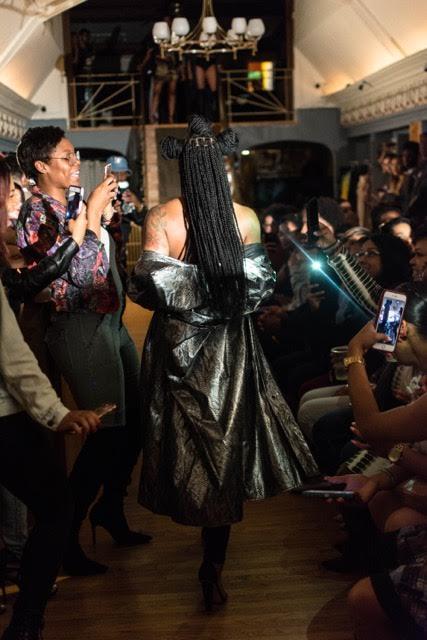
The energy was at a steady hum inside the doors of Muse Clothing on Ninth Street, as a mix of people filed through the doors on Friday, April 28. Spectators crowded around the sales floor in the dim lighting in anticipation of a fashion show.
Appropriately titled #ThisIsAmerica, Muse hosted the show to appreciate the diverse complexion of this country, a celebration of all races, body types, sexual orientations and nationalities.
The show opened with a poetry reading and a swanky acoustic rendition of Anita Baker’s “Caught up in the Rapture.” Then the spotlight shifted to the massive staircase at the back of the store, where models were casually seated. The music started; models of every shape, size, color and gender made their way down the runway.
“It was very different, it was very diverse and it was just nice to see different types of people modeling. It was really just beautiful,” Grace Flowers, a senior who attended the event, said.
Split into two main walks, Muse brought together looks from its own inventory, as well as garments from local designers Stephanie Carlo and Larry Greer.
Current trends like mesh and cutouts were present. Jackets slung off the shoulder gave an edgy but effortless feel. Models rocked daring hairstyles and a sporty chic vibe prevailed. Local brands such as Como Beach even made an appearance.
Playing into the theme of the show, at one point, models of different genders were sent down two at a time, walking down separate ways and meeting in the middle. The models, with sunglasses on and hair slicked down, sported nearly androgynous outfits, reflective of each other, but each tweaked in different ways. The looks demanded attention.
After a brief intermission, models showcased work by local designers. A motif of monochromatic digital prints manifested across an array of coats and dresses ended the show on a refined note.
Aside from the dynamic clothing, the most noticeable contribution to the energy in the room was the crowd. Spectators were cheering and hyping up the models through every pass; some cheering for their friends who were cast for the show, some for total strangers.
“Fashion shows aren’t usually like that, but everyone was so supportive of everyone,” Flowers said after the show.
It was this sense of community that drove home the purpose of the show.
Beyond serving the looks that were styled to fit each of them, with each step the models took, they carried the message of acceptance and unity.
“There’s people here you wouldn’t see in, I guess, a ‘regular’ fashion show, which is the point of this: So you can get people out there to do the same thing,” model Zoe Westhoff said.
Fellow model Alejandra Lopez Mendoza, a senior at Rock Bridge High School, agreed that highlighting diversity was crucial now, and for the future.
“I would hope that more of these things would happen and become bigger so [the industry] sees the difference of ‘this would be better, this is what the people like,’” Lopez Mendoza said.
Aspiring to one day be involved in the fashion industry, Lopez Mendoza is optimistic about the symbiotic relationship of fashion and diversity.
“Having a variety makes people more empowered, so hopefully this is a step forward,” Lopez Mendoza said.
The push for better representation in the wide world of fashion is a movement that’s seeing growth. As far as creative director Sydney Rosee is concerned, Columbia can definitely expect to see more.
“I had a vision when I was like 12 about a fashion show, but I didn’t know what it was, so I feel like this was part of my vision,” Rosee said. “But it’s not the show that I want. I wanted this show, but my plan is for a bigger show. So this is my first step.”
_Edited by Libby Stanford | [email protected]_